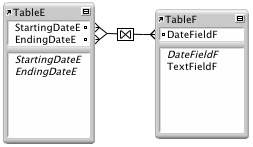About relationships that return a range of records
A relationship that returns a range of records is similar to a multi-criteria relationship, except that you use comparative operators to find records that are greater than one of your criteria and less than your other criteria. This type of relationship is commonly used to return records that fall between a range of dates or serial numbers.
For example, from within TableE you would like to view all the records in TableF that have DateFieldF values that are greater than StartingDateE and less than EndingDateE.
In the relationships graph, the  symbol indicates that different relational operators are being used in this relationship.
symbol indicates that different relational operators are being used in this relationship.
This relationship returns those records from TableF that have a DateFieldF value that is later than StartingDateE and earlier than EndingDateE.
For example, when the StartingDateE value is 11/01/2010 and the EndingDateE value is 12/01/2010, the relationship returns the following related records from TableF.
When the StartingDateE value is 12/01/2010 and the EndingDateE value is 01/01/2011, the relationship returns the following related records.

